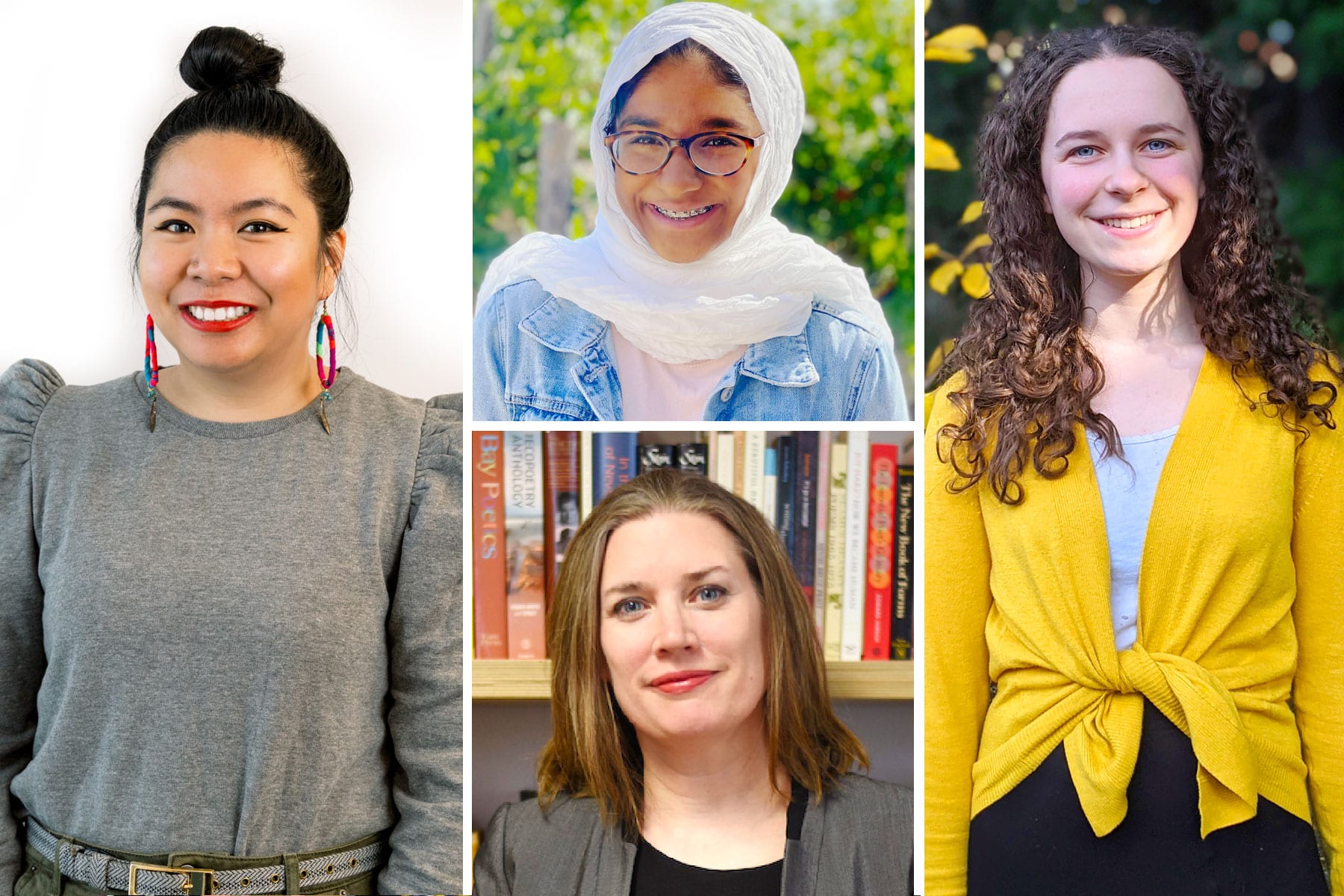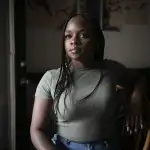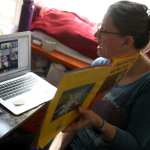Janice Lobo Sapigao watched in awe as her students engaged with the questions: What does freedom look like? What does it feel like? What does it sound like?
Sapigao, who has been teaching poetry in Santa Clara, California, for over 10 years, thought just three students would show up to her independent virtual youth poetry workshop — that’s the usual turnout. But the week of the inauguration this January, she had over 25 students. The next workshop had 40. Then 70.
“We are here for ourselves,” Sapigao remembers one student answering when she asked why people decided to spend their evening learning and writing with her.
“There were young people. There were strong lines. There were beautiful poems,” Sapigao said. “There were emotions, and there was an attempt to just write.”
In Sapigao’s class and in her free time, Sarah Mohammed, 15, wrote about laughing with her mother at night, folding fresh laundry — still warm from the dryer — and imagining her grandmother back in India braiding her hair. Sixteen-year-old Sophia Smith wrote about what it feels like to put your feet on the carpet each morning, finding a sense of strength and stability in this uncertain time.
For the past year, many teens have been deprived of the key social interactions — teams, groups and communities in and outside of school — that help them hone their independence and confidence, experts say. And that has compromised students’ mental health. Young adults and adolescents reported higher rates of anxiety and depression during the pandemic. For those 13 to 18, mental health insurance claims doubled in March and April of last year compared with 2019. Researchers found that 46 percent of 977 parents of teens said their child showed signs of a “new or worsening mental health condition since the start of the pandemic,” with a larger percentage of parents of teen girls reporting an increase in anxiety or worry in their child. LGBTQ+ teens are also at more risk for mental health issues during this time, compounded by the everyday struggles many already face.
Sapigao, who serves as the Santa Clara county poet laureate, made it her mission to observe how the pandemic has affected the young people in her own town. As someone passionate about working with young people and worried about her students’ social isolation, she thought she could teach them to write about their feelings through poetry.
She met with students from her local high school for a poetry workshop. Many were not sleeping well anymore. Others said “existential crises” kept coming up. A majority mentioned how politics and the greater landscape of the global pandemic compounded with the ongoing fight for racial justice has caused them immense stress and anxiety. They deeply understand the world they are a part of, Sapigao said. And she found that many of them are turning to poetry to help them understand it even better.
Mohammed, Sapigao’s student, writes poetry as a way to engage with her Muslim-American identity, a connection with her family and her ancestors back in India while making sense of the turmoil she has seen this year in her own community in California. She feels comfortable in the vulnerability, she said, because she recognizes herself in other poets.
“I haven’t seen a lot of Muslim women or even just women of color being in levels of leadership. I haven’t had role models like that. Being able to look up to a woman of color in leadership, that’s something that’s drawn me a lot,” Mohammed said. “I’ve talked to other teen writers, and we share the sentiment that you can find writers who look like you. I’m not alone. And in a world with a pandemic, I think seeing faces like that, and being mentored by these writers is really gratifying.”
It also gives her the chance to slow down — a quiet distraction from the fast-paced nature of social media, she said.
“I think one thing that drew me to poetry was that I never felt rushed. I always felt like I could move at my own pace, and that sort of helps me unlock and unpack my struggles,” Mohammed said.
Smith, Mohammed’s friend and fellow student, said poetry is the “great equalizer” for young people — there are no barriers to access. In a time of social isolation, poetry has formed a sense of community, she said. It has been a tool to process the loss of high school normalcy and the chaos of the outside world.
“You hear about people going through immense hardship and immense joy, and you can really connect with those emotions,” Smith said. “I think that’s where the sense of community comes from. You feel like there’s a space open to you. Even though you’re not talking to this person directly, you can still kind of feel their words, and you can kind of feel the state they were in when they were writing it.”
Creative art therapy — writing, poetry, music, movement or a combination — has proved to be a tool in helping young people process trauma, said Cathy Malchiodi, a psychologist of 30 years and author of the book “Trauma and Expressive Arts Therapy.” Malchiodi explains it in the form of music. When someone hears a song, they can tap into a beat, get taken to a memory or even calm down. Poetry can have the same effect, she said. In poetry and writing in general, students can write in the third person, which is a much calmer way to articulate hardship, Malchiodi said.
“If you switch to the third person and make it into a worry, or give it another name, and then read that story out loud, it’s much easier to hear that talk about that story, and [it can be] much less traumatic,” Malchiodi said.
With many of the teens Malchiodi works with, she simply tells them to write whatever may come up and not to worry about the quality of the work. It’s a preventative process, a way to make sense of this uncertain year and build resiliency, she said.
“When we’re traumatized, we lose kind of our sense of play, we sometimes even lose contact with our imagination,” Malchiodi said. “So how do we get that back? Because those are really healing factors in everyone’s life. To be able to play, to be able to imagine, to be able to experience joy again.”
To gain that sense of imagination again, young people have engaged in poetry at increasing rates this year. In 2020, the Academy of American Poets, a national member-supported organization that promotes the art of poetry, received 3,035 letters from students across 38 different states, compared with around 1,000 letters in previous years. And that was before 22-year-old Amanda Gorman struck a chord with her poem “The Hill We Climb” at the president’s inauguration in January, shortly before Sapiago saw her class sizes spike.
Due to the increase in letters in 2020, Jen Benka, the group’s president and executive director, foresees the number of engaged readers and writers growing even more this year. Before the pandemic, among 18- to 24-year-olds, the poetry-reading rate more than doubled to 17.5 percent in 2017 from 8.2 percent in 2012. Additionally, 46.1 percent of children and young people engage with poetry — meaning they read, listen or watch poetry — in their free time, according to a 2018 research study from National Literacy Trust. Roughly 11 percent write or perform poetry, according to the study. Women typically make up over 60 percent of poetry readers and Black, Asian Americans and other non-White groups make up the bulk of poetry readers.
“It gives them an opportunity to put their fears somewhere. A poem can be a place that holds and contains those feelings that young people might not otherwise feel comfortable saying out loud,” Benka said. “We are experiencing overlapping historic events — a global pandemic, unprecedented calls for justice and systemic racism, climate change and the future of the health of our planet. We are in a moment in time that is overwhelming and is unlike anything in the history of our planet.”
Gorman propelled the power of poetry in January. She performed her poem aimed at unification, at the unfinished nature of our nation and at love and peace in a time of grief. It doesn’t shock Benka that poetry had the power to spread rampantly through group chats, classrooms and social media alike and that it was written and performed by a young person.
“The intensity of this moment, and the longing that we have had for someone to stand up in front of us and map a way forward in language, literally to tell us what is possible now,” Benka said, “And that’s what Amanda did.”
When she recited, “For there was always light. If only we’re brave enough to see it,” she gave the nation a hope they didn’t know they needed, Benka said.
“Whether we have been aware or not, we have been terrified since March. We were desperate for a positive message. We were desperate for a message of hope. We were desperate for someone to just say the truth,” Benka said.
Young people are doing just that — helping map a way forward in this ongoing year of loss and uncertainty.
“I see myself more clearly, but I also see my surroundings more clearly,” Smith said.





